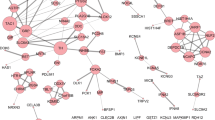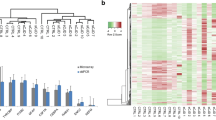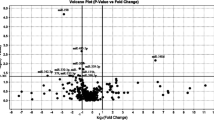Abstract
MicroRNAs (miRNAs) play an important role in human brain development and maintenance. To search for miRNAs that may be involved in the pathogenesis of Parkinsons disease (PD), we utilized miRNA microarrays to identify potential gene expression changes in 115 annotated miRNAs in PD-associated Caenorhabditis elegans models that either overexpress human A53T α-synuclein or have mutations within the vesicular catecholamine transporter (cat-1) or parkin (pdr-1) ortholog. Here, we show that 12 specific miRNAs are differentially regulated in the animals overexpressing α-synuclein, five in cat-1, and three in the pdr-1 mutants. The family of miR-64 and miR-65 are co-underexpressed in the α-synuclein transgenic and cat-1 strains, and members of let-7 family co-underexpressed in the α-synuclein and pdr-1 strains; mdl-1 and ptc-1 genes are target candidates for miR-64 and miR-65 and are overexpressed in α-synuclein transgenic as well as miR-64/65 (tm3711) knockout animals. These results indicate that miRNAs are differentially expressed in C. elegans PD models and suggest a role for these molecules in disease pathogenesis.


Similar content being viewed by others
References
Abbott AL, Alvarez-Saavedra E, Miska EA, Lau NC, Bartel DP, Horvitz HR, Ambros V (2005) The let-7 MicroRNA family members mir-48, mir-84, and mir-241 function together to regulate developmental timing in Caenorhabditis elegans. Dev Cell 9(3):403–414
Abrahante JE, Daul AL, Li M, Volk ML, Tennessen JM, Miller EA, Rougvie AE (2003) The Caenorhabditis elegans hunchback-like gene lin-57/hbl-1 controls developmental time and is regulated by microRNAs. Dev Cell 4(5):625–637
Alvarez-Garcia I, Miska EA (2005) MicroRNA functions in animal development and human disease. Development 21:4653–4662
Ambros V, Lee RC, Lavanway A, Williams PT, Jewell D (2003) MicroRNAs and other tiny endogenous RNAs in C.elegans. Curr Biol 13:807–818
Braak H, Del Tredici K, Rüb U, de Vos RA, Jansen Steur EN, Braak E (2003) Staging of brain pathology related to sporadic Parkinson's disease. Neurobiol Aging 24(2):197–211
Brenner S (1974) The genetics of Caenorhabditis elegans. Genetics 77:71–94
Cacchiarelli D, Santoni D, Bozzoni I (2008) MicroRNAs as prime players in a combinatorial view of evolution. RNA Biol 5(3):120–122
Denli AM, Tops BB, Plasterk RH, Ketting RF, Hannon GJ (2004) Processing of primary microRNAs by the microprocessor complex. Nature 432(7014):231–235
Duerr JS, Frisby DL, Gaskin J, Duke A, Asermely K, Huddleston D, Eiden LE, Rand JB (1999) The cat-1 gene of Caenorhabditis elegans encodes a vesicular monoamine transporter required for specific monoamine-dependent behaviors. J Neurosci 19(1):72–84
Farrer M, Gwinn-Hardy K, Hutton M, Hardy J (1999) The genetics of disorders with synuclein pathology and parkinsonism. Hum Mol Genet 8(10):1901–1905
Ferretti E, De Smaele E, Miele E, Laneve P, Po A, Pelloni M, Paganelli A, Di Marcotullio L, Caffarelli E, Screpanti I, Bozzoni I, Gulino A (2008) Concerted microRNA control of Hedgehog signalling in cerebellar neuronal progenitor and tumour cells. EMBO J 27(19):2616–2627
Frasch M (2008) A matter of timing: microRNA-controlled temporal identities in worms and flies. Genes Dev 22(12):1572–1576
Grosshans H, Johnson T, Reinert KL, Gerstein M, Slack FJ (2005) The temporal patterning microRNA let-7 regulates several transcription factors at the larval to adult transition in C. elegans. Dev Cell 8(3):321–330
Hardy J, Cai H, Cookson MR, Gwinn-Hardy K, Singleton A (2006) Genetics of Parkinson's disease and parkinsonism. Ann Neurol 60(4):389–398
Hayes GD, Frand AR, Ruvkun G (2006) The mir-84 and let-7 paralogous microRNA genes of Caenorhabditis elegans direct the cessation of molting via the conserved nuclear hormone receptors NHR-23 and NHR-25. Development 133(23):4631–4641
Heimberg AM, Sempere LF, Moy VN, Donoghue PC, Peterson KJ (2008) MicroRNAs and the advent of vertebrate morphological complexity. Proc Natl Acad Sci U S A 105(8):2946–2950
Junn E, Lee K-W, Jeong BS, Chan TW, Im J-Y, Mouradian MM (2009) Repression of α-synuclein expression and toxicity by microRNA-7. Proc Natl Acad Sci U S A 106(31):13052–13057
Kim J, Inoue K, Ishii J, Vanti WB, Voronov SV, Murchison E, Hannon G, Abeliovich A (2007) A MicroRNA feedback circuit in midbrain dopamine neurons. Science 317(5842):1220–1224
Kim YK, Kim VN (2007) Processing of intronic microRNAs. EMBO J 26(3):775–783
Kitada T, Asakawa S, Hattori N, Matsumine H, Yamamura Y, Minoshima S, Yokochi M, Mizuno Y, Shimizu N (1998) Mutations in the parkin gene cause autosomal recessive juvenile parkinsonism. Nature 392(6676):605–608
Krichevsky AM, King KS, Donahue CP, Khrapko K, Kosik KS (2003) A microRNA array reveals extensive regulation of microRNAs during brain development. RNA 9(10):1274–1281
Krichevsky AM, Sonntag KC, Isacson O, Kosik KS (2006) Specific microRNAs modulate embryonic stem cell-derived neurogenesis. Stem Cells 24(4):857–864
Kuwabara PE, Lee MH, Schedl T, Jefferis GS (2000) A C. elegans patched gene, ptc-1, functions in germ-line cytokinesis. Genes Dev 14:1933–1944
Lagos-Quintana M, Rauhut R, Yalcin A, Meyer J, Lendeckel W, Tuschl T (2002) Identification of tissue-specific microRNAs from mouse. Curr Biol 12(9):735–739
Lakso M, Vartiainen S, Moilanen AM, Sirviö J, Thomas JH, Nass R, Blakely RD, Wong G (2003) Dopaminergic neuronal loss and motor deficits in Caenorhabditis elegans overexpressing human α-synuclein. J Neurochem 86(1):165–172
Lai EC (2002) Micro RNAs are complementary to 3' UTR sequence motifs that mediate negative post-transcriptional regulation. Nat Genet 30(4):363–364
Lazzarini AM, Myers RH, Zimmerman TR Jr, Mark MH, Golbe LI, Sage JI, Johnson WG, Duvoisin RC (1994) A clinical genetic study of Parkinson's disease: evidence for dominant transmission. Neurology 44(3 Pt 1):499–506
Lee RC, Feinbaum RL, Ambros V (1993) The C.elegans heterochronic gene lin-4 encodes small RNAs with antisense complementarity to lin-14. Cell 75:843–954
Liao P, Chen T, Chung P (2001) A fast algorithm for multilevel thresholding. J Info Sci Eng 17:713–727
Lim LP, Glasner ME, Yekta S, Burge CB, Bartel DP (2003a) Vertebrate microRNA genes. Science 299(5612):1540
Lim LP, Lau NC, Weinstein EG, Abdelhakim A, Yekta S, Rhoades MW, Burge CB, Bartel DP (2003b) The microRNAs of Caenorhabditis elegans. Genes Dev 17(8):991–1008
Lim LP, Lau NC, Garrett-Engele P, Grimson A, Schelter JM, Castle J, Bartel DP, Linsley PS, Johnson JM (2005) Microarray analysis shows that some microRNAs downregulate large numbers of target mRNAs. Nature 433(7027):769–773
Livak KJ, Schmittgen TD (2001) Analysis of relative gene expression data using real-time quantitative PCR and the 2(-Delta Delta C(T)) Method. Methods 25(4):402–408
Loer CM, Kenyon CJ (1993) Serotonin-deficient mutants and male mating behavior in the nematode Caenorhabditis elegans. J Neurosci 13:5407–5417
Mata IF, Lockhart PJ, Farrer MJ (2004) Parkin genetics: one model for Parkinson's disease. Hum Mol Genet 13(Spec No 1):R127–R133
Niwa R, Zhou F, Li C, Slack FJ (2008) The expression of the Alzheimer's amyloid precursor protein-like gene is regulated by developmental timing microRNAs and their targets in Caenorhabditis elegans. Dev Biol 315(2):418–425
Polymeropoulos MH, Lavedan C, Leroy E, Ide SE, Dehejia A, Dutra A, Pike B, Root H, Rubenstein J, Boyer R, Stenroos ES, Chandrasekharappa S, Athanassiadou A, Papapetropoulos T, Johnson WG, Lazzarini AM, Duvoisin RC, Di Iorio G, Golbe LI, Nussbaum RL (1997) Mutation in the α-synuclein gene identified in families with Parkinson's disease. Science 276(5321):2045–2047
Reinhart BJ, Slack FJ, Basson M, Pasquinelli AE, Bettinger JC, Rougvie AE, Horvitz HR, Ruvkun G (2000) The 21-nucleotide let-7 RNA regulates developmental timing in Caenorhabditis elegans. Nature 403(6772):901–906
Reinhart BJ, Weinstein EG, Rhoades MW, Bartel B, Bartel DP (2002) MicroRNAs in plants. Genes Dev 16(13):1616–1626
Revuelta GJ, Rosso A, Lippa CF (2008) Association between progranulin and {beta}-amyloid in dementia with lewy bodies. Am J Alzheimers Dis Other Demen 23(5):488–493
Roush S, Slack FJ (2008) The let-7 family of microRNAs. Trends Cell Biol 18(10):505–516
Saeed AI, Sharov V, White J, Li J, Liang W, Bhagabati N, Braisted J, Klapa M, Currier T, Thiagarajan M, Sturn A, Snuffin M, Rezantsev A, Popov D, Ryltsov A, Kostukovich E, Borisovsky I, Liu Z, Vinsavich A, Trush V, Quackenbush J (2003) TM4: a free, open-source system for microarray data management and analysis. Biotechniques 34(2):374–378
Sawin ER (1996) Genetic and cellular analysis of modulated behaviours in Caenorhabditis elegans. PhD thesis, Massachusetts Institute of Technology
Schaefer A, O'Carroll D, Tan CL, Hillman D, Sugimori M, Llinas R, Greengard P (2007) Cerebellar neurodegeneration in the absence of microRNAs. J Exp Med 204(7):1553–1558
Schratt GM, Tuebing F, Nigh EA, Kane CG, Sabatini ME, Kiebler M, Greenberg ME (2006) A brain-specific microRNA regulates dendritic spine development. Nature 439(7074):283–289
Sempere LF, Freemantle S, Pitha-Rowe I, Moss E, Dmitrovsky E, Ambros V (2004) Expression profiling of mammalian microRNAs uncovers a subset of brain-expressed microRNAs with possible roles in murine and human neuronal differentiation. Genome Biol 5(3):R13
Shimura H, Hattori N, Kubo S, Mizuno Y, Asakawa S, Minoshima S, Shimizu N, Iwai K, Chiba T, Tanaka K, Suzuki T (2000) Familial Parkinson disease gene product, parkin, is a ubiquitin-protein ligase. Nat Genet 25(3):302–305
Singleton AB, Farrer M, Johnson J, Singleton A, Hague S, Kachergus J, Hulihan M, Peuralinna T, Dutra A, Nussbaum R, Lincoln S, Crawley A, Hanson M, Maraganore D, Adler C, Cookson MR, Muenter M, Baptista M, Miller D, Blancato J, Hardy J, Gwinn-Hardy K (2003) A-Synuclein locus triplication causes Parkinson's disease. Science 302(5646):841
Springer W, Hoppe T, Schmidt E, Baumeister R (2005) A Caenorhabditis elegans Parkin mutant with altered solubility couples α-synuclein aggregation to proteotoxic stress. Hum Mol Gen 14:3407–3423
Sulston J, Dew M, Brenner S (1975) Dopaminergic neurons in the nematode Caenorhabditis elegans. J Comp Neurol 163:215–226
Tan EK, Skipper LM (2007) Pathogenic mutations in Parkinson disease. Hum Mutat 28(7):641–653
Tay Y, Zhang J, Thomson AM, Lim B, Rigoutsos I (2008) MicroRNAs to Nanog, Oct4 and Sox2 coding regions modulate embryonic stem cell differentiation. Nature 455(7216):1124–1128
Vartiainen S, Pehkonen P, Lakso M, Nass R, Wong G (2006) Identification of gene expression changes in transgenic C. elegans overexpressing human alpha-synuclein. Neurobiol Dis 22(3):477–486
Ved R, Saha S, Westlund B, Perier C, Burnam L, Sluder A, Hoener M, Rodrigues CM, Alfonso A, Steer C, Liu L, Przedborski S, Wolozin B (2005) Similar patterns of mitochondrial vulnerability and rescue induced by genetic modification of α-synuclein, parkin, and DJ-1 in Caenorhabditis elegans. J Biol Chem 280:42655–42668
Yokota T, Sugawara K, Ito K, Takahashi R, Ariga H, Mizusawa H (2003) Down regulation of DJ-1 enhances cell death by oxidative stress, ER stress, and proteasome inhibition. Biochem Biophys Res Commun 312(4):1342–1348
Yu JY, Chung KH, Deo M, Thompson RC, Turner DL (2008) MicroRNA miR-124 regulates neurite outgrowth during neuronal differentiation. Exp Cell Res 314(14):2618–2633
Acknowledgements
We thank the Finnish Graduate School of Neurosciences (FGSN), the Saastamoinen Foundation, and the Sigrid Juselius Foundation for their financial support. This study was supported in part by NIH ES014459 and MHRP W81XWH-05-1-0239 to RN. We thank Petri Pehkonen and Antti Kurronen for advice in computer analysis and Markus Storvik, Vuokko Aarnio, and Julia Vistbakka for fruitful discussions. We thank Dr. Shohei Mitani (Tokyo Women’s Medical University) for providing djr-1.1 and pink-1, and miR-64/65 (tm3711) mutant strains. Some strains used in this study were obtained from the C. elegans Genetics Center, which is funded by the NIH.
Authors' contributions
SA planned and performed the experiments and wrote the manuscript. MR, LH, KL, JV, and ML performed experiments. GW planned and performed experiments and helped write the manuscript. RN provided critical reagents, guided the study, and helped write the manuscript.
Author information
Authors and Affiliations
Corresponding authors
Electronic supplementary materials
Below is the link to the electronic supplementary material.
Supplementary Table 1
All miRNAs detected in the microarray experiment (DOCX 22 kb)
Supplementary Table 2
miRNAs missing from the NCode miRNA microarray platform (DOCX 15 kb)
Rights and permissions
About this article
Cite this article
Asikainen, S., Rudgalvyte, M., Heikkinen, L. et al. Global microRNA Expression Profiling of Caenorhabditis elegans Parkinson's Disease Models. J Mol Neurosci 41, 210–218 (2010). https://doi.org/10.1007/s12031-009-9325-1
Received:
Accepted:
Published:
Issue Date:
DOI: https://doi.org/10.1007/s12031-009-9325-1




